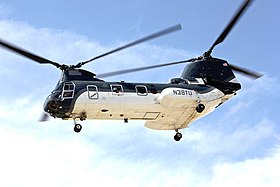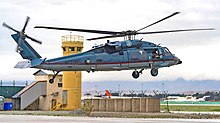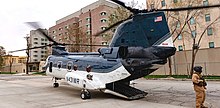
The Boeing Vertol CH-46 Sea Knight is an American medium-lift tandem-rotor transport helicopter powered by twin turboshaft engines. It was designed by Vertol and manufactured by Boeing Vertol following Vertol's acquisition by Boeing.

The Boeing CH-47 Chinook is a tandem-rotor helicopter originally developed by American rotorcraft company Vertol and now manufactured by Boeing Defense, Space & Security. The Chinook is a heavy-lift helicopter that is among the heaviest lifting Western helicopters. Its name, Chinook, is from the Native American Chinook people of Oregon and Washington state.

DynCorp, formally DynCorp International, was an American private military contractor. Started as an aviation company, the company also provided flight operations support, training and mentoring, international development, intelligence training and support, contingency operations, security, and operations and maintenance of land vehicles. DynCorp received more than 96% of its more than $3 billion in annual revenue from the U.S. federal government. The corporate headquarters were in an unincorporated part of Fairfax County near Falls Church, Virginia, while the company's contracts were managed from its office at Alliance Airport in Fort Worth, Texas. DynCorp provided services for the U.S. military in several theaters, including Bolivia, Bosnia, Somalia, Angola, Haiti, Colombia, Kosovo and Kuwait. It also provided much of the security for Afghan president Hamid Karzai's presidential guard and trained much of the police forces of Iraq and Afghanistan. DynCorp was also hired to assist recovery in Louisiana and neighboring areas after Hurricane Katrina. The company held one contract on every round of competition since receiving the first Contract Field Teams contract in 1951.

The Australian contribution to the war in Afghanistan has been known as Operation Slipper (2001–2014) and Operation Highroad (2015–2021).

Kabul International Airport is located in the northern part of Kabul, Afghanistan. It is one of the country's main international airports, capable of housing over a hundred military and civilian aircraft. It is currently operated by UAE-based GAAC Holding and Afghanistan's Ministry of Transport and Civil Aviation.

The CH-53 Sea Stallion is an American family of heavy-lift transport helicopters designed and built by the American manufacturer Sikorsky Aircraft. The Sea Stallion was originally developed in response to a request from the United States Navy's Bureau of Naval Weapons made in March 1962 for a replacement for the Sikorsky CH-37 Mojave helicopters flown by the United States Marine Corps (USMC).

Operation Frequent Wind was the final phase in the evacuation of American civilians and "at-risk" Vietnamese from Saigon, South Vietnam, before the takeover of the city by the North Vietnamese People's Army of Vietnam (PAVN) in the Fall of Saigon. It was carried out on 29–30 April 1975, during the last days of the Vietnam War. More than 7,000 people were evacuated by helicopter from various points in Saigon. The airlift resulted in a number of enduring images.

The General Command of the Air Force ,(Dari: فرماندهی کل نیروی هوایی) also referred to as the Islamic Emirate Air Force and the Afghan Air Force, is the air force branch of the Afghan Armed Forces.
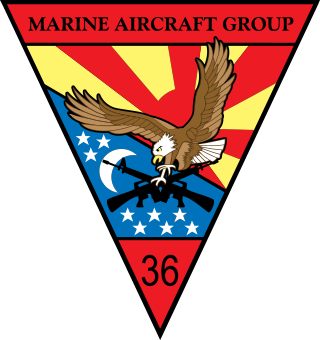
Marine Aircraft Group 36 (MAG-36) is an active air group of the United States Marine Corps, tasked with providing assault support aircraft. It is currently part of the 1st Marine Aircraft Wing, itself an integral part of the III Marine Expeditionary Force, and based at Marine Corps Air Station Futenma in Okinawa, Japan.
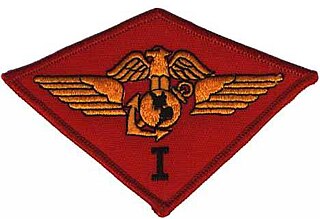
The 1st Marine Aircraft Wing is an aviation unit of the United States Marine Corps that serves as the Aviation Combat Element of the III Marine Expeditionary Force. The wing is headquartered at Camp Foster on the island of Okinawa, Japan. Activated in 1940, the wing has seen heavy combat operations during World War II, the Korean War, and the Vietnam War.

The 5th Aviation Regiment is an Australian Army aviation unit. Formed in 1987 after the Army took over responsibility for operating helicopters from the Royal Australian Air Force, the regiment is based at RAAF Base Townsville, in Queensland. It currently forms part of the 16th (Aviation) Brigade and it operates the majority of the Army's transport helicopters. Throughout its existence, the regiment has been deployed overseas numerous times, supporting both peacekeeping and warlike operations. Since its formation elements of the regiment have made operational deployments to Cambodia, Papua New Guinea, East Timor, Iraq, Indonesia and Pakistan.

Marine Medium Tilt Rotor Squadron 165 (VMM-165) is a United States Marine Corps Tilt-rotor squadron consisting of MV-22B Osprey transport aircraft. The squadron, known as the "White Knights", is based at Marine Corps Air Station Miramar, California and fall under the command of Marine Aircraft Group 16 (MAG-16) and the 3rd Marine Aircraft Wing.

Marine Heavy Helicopter Squadron 464 (HMH-464) is a United States Marine Corps helicopter squadron consisting of CH-53E Super Stallion transport helicopters. The squadron is known as the "Condors" and is based at Marine Corps Air Station New River, North Carolina. They fall under the command of Marine Aircraft Group 29 (MAG-29) and the 2nd Marine Aircraft Wing.

Marine Medium Tiltrotor Squadron 365 (VMM-365) is a United States Marine Corps tiltrotor squadron consisting of MV-22B Osprey transport aircraft. The squadron, known as the "Blue Knights", is based at Marine Corps Air Station New River, North Carolina and falls under the command of Marine Aircraft Group 26 (MAG-26) and the 2nd Marine Aircraft Wing.

The Bureau of International Narcotics and Law Enforcement Affairs (INL) is an agency that reports to the Under Secretary for Civilian Security, Democracy, and Human Rights within the United States Department of State. Under the umbrella of its general mission of developing policies and programs to combat international narcotics and crime, INL plays an important role in the training of partner nation security forces.

Marine Heavy Helicopter Squadron 463 (HMH-463) was a United States Marine Corps helicopter squadron consisting of CH-53E Super Stallion transport helicopters. The squadron, also known as "Pegasus", was last based at Marine Corps Air Station Kaneohe Bay, Hawaii and fell under the command of Marine Aircraft Group 24 (MAG-24) and the 1st Marine Aircraft Wing. HMH-463 was decommissioned in April 2022 as part of the Commandant of the Marine Corps Force Design 2030 initiative.

Operation Eagle Pull was the United States military evacuation by air of Phnom Penh, Cambodia, on 12 April 1975. At the beginning of April 1975, Phnom Penh, one of the last remaining strongholds of the Khmer Republic, was surrounded by the Khmer Rouge and totally dependent on aerial resupply through Pochentong Airport. With a Khmer Rouge victory imminent, the US government made contingency plans for the evacuation of US nationals and allied Cambodians by helicopter to ships in the Gulf of Thailand. Operation Eagle Pull took place on the morning of 12 April 1975 and was a tactical success carried out without any loss of life. Five days later the Khmer Republic collapsed and the Khmer Rouge occupied Phnom Penh.

The Embassy of the United States of America in Kabul was the official diplomatic mission of the United States of America to the Islamic Republic of Afghanistan. The embassy was housed in a chancery located on Great Massoud Road in the Wazir Akbar Khan neighborhood of the Afghan capital, Kabul, and was built at a cost of nearly $800 million. On August 15, 2021, in the face of a Taliban advance on Kabul, embassy staff relocated to makeshift but secure facilities at Hamid Karzai International Airport. Kabul fell and the chancery building officially closed late August 15th.

Large-scale evacuations of foreign citizens and some vulnerable Afghan citizens took place amid the withdrawal of US and NATO forces at the end of the 2001–2021 war in Afghanistan. The Taliban took control of Kabul and declared victory on 15 August 2021, and the NATO-backed Islamic Republic of Afghanistan collapsed. With the Taliban controlling the whole city except Hamid Karzai International Airport, hostilities ceased and the Taliban assisted in the evacuation effort by providing security and screening evacuees.

